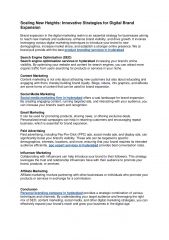Fundamentals of Marketing: Product Identification and Branding Insights
Explore the essential concepts of marketing including the marketing mix, product identification methodology, and the significance of branding in differentiating products. Learn about the 4Ps of marketing mix - Product, Price, Place, and Promotion, and how branding plays a crucial role in establishing a unique identity for products. Delve into the importance of product identification for tracking items in the supply chain. Gain valuable insights into the role of branding in creating distinctiveness and customer loyalty in a competitive market.
Download Presentation

Please find below an Image/Link to download the presentation.
The content on the website is provided AS IS for your information and personal use only. It may not be sold, licensed, or shared on other websites without obtaining consent from the author.If you encounter any issues during the download, it is possible that the publisher has removed the file from their server.
You are allowed to download the files provided on this website for personal or commercial use, subject to the condition that they are used lawfully. All files are the property of their respective owners.
The content on the website is provided AS IS for your information and personal use only. It may not be sold, licensed, or shared on other websites without obtaining consent from the author.
E N D
Presentation Transcript
I. B. (PG) COLLEGE, PANIPAT AFFILIATED TO KURUKSHETRA UNIVERSITY, KURUKSHETRA CLASS : B.COM. IIND SEMESTER SUBJECT : FUNDAMENTALS OF MARKETING TOPIC : PRODUCT IDENTIFICATION PRODUCED BY : PROF. SONIA DHINGRA
MARKETING - MIX The marketing mix refers to the set of actions, or tactics, that a company uses to promote its brand or product in the marketing. The 4P s make up a typical marketing mix- Product, Price, Place and Promotion
MARKETING MIX PLACE PRODUCT PRICE PROMOTION Variety Features Quality Design Branding Packaging labeling List price Discounts Allowances Payment period Credit terms Channels Coverage Assortments Locations Inventory Transport Sales Promotion Advertising Public Relations Direct Marketing
PRODUCT IDENTIFICATION Product Identification is a methodology which helps in identifying a product without a full specifications specified on the label. In case of shipping and transportation of the items each and every document associated with the product carries this unique Product ID. It helps in tracking the item in any part of the supply chain.
BRANDING Branding is a practice of giving a specified name to a product or group of product of one seller. Branding is the process of finding and fixing the means of identification. Example Apple Mobile Phone
DEFINITION OF BRANDING American Marketing Association has defined Brand as A name, term, sign, symbol or design, or a combination of them, intended to identify the goods or services of one seller or group of sellers and to differentiate them from those of competitors.
WHY BRAND ? A brand name helps an organisation differentiate itself from its competitors. In today s competitive world customers expect products to have brand. Some people will only purchase a particular brand even though there are acceptable alternatives in the market Example Samsung Mobile Phone
BRAND NAME A brand name is the name that a business chooses for one of their products. A brand identifies a specific product or name of a company. Example: Nike BRAND MARK The design element such as symbol, character, logo or anything that provide a recognition to a specified product. Example : Nike Swoosh. TRADE MARK A trademark is a registered brand name. It can include any combination of a name, slogan, logo, sounds or colours that identify the company or its products or services. Example: Nike Swoosh.
PACKAGING Packaging is an art of making one s goods more attractive among competitors. It also gives security and safety to the commodity while transporting from one place to another. PACKAGE A good package is the representation of the artistic combination of the designers creative skills and the marketing policies of the company
TYPES OF PACKAGING Transport Packaging The product entering in to the trade need to be packed well enough to protect against loss damage during handling, transport and storage. Example : Fiberboard, Wooden Crate etc. Consumer Packing This packaging holds the required volume of the product for ultimate consumption and is more relevant in marketing. Example : Beverages, Tobacco etc.
PURPOSE OF PACKAGING Promoting and Selling the Product Defining Product Identity Providing Information Expressing Customer Needs Ensure Safe Use Protecting the Product Effective Segmentation
LABELLING Product labelling is a part of the packaging of a product. It is defined as the process of attaching a descriptive word or phrase to someone or something. These written labels on the package cover important information which needs to be communicated to a customer. The seller must label the products.
FUNCTIONS OF LABELLING It enables the producer to give a clear instruction about the users of a product. Price variation caused by middleman are avoided because of price is maintained and printed. It encourages producer to make only standard products. Buyers can easily identify the product.























